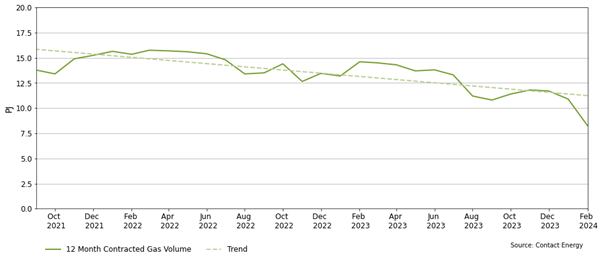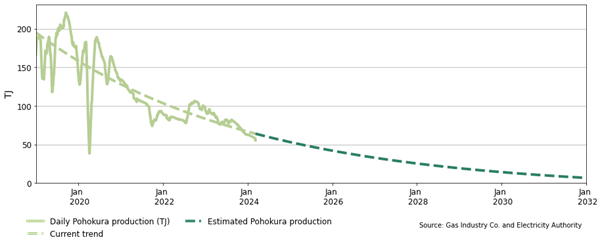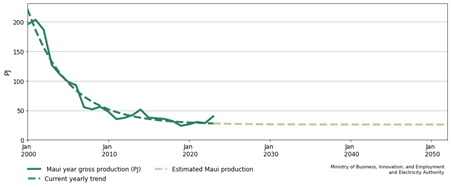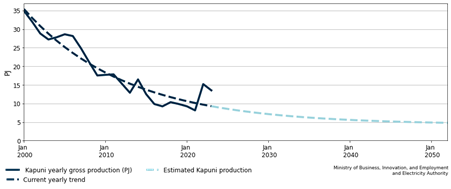Eye on electricity
Natural gas and the electricity sector transition
- Generation
Electricity in New Zealand is supplied by hydro dams, wind farms, geothermal power stations, a few solar farms and thermal power stations – with some using natural gas as fuel.
The New Zealand Government has committed to net zero emissions by 2050 and fossil fuels are being phased out, including in the electricity sector. This article discusses the current and future use of natural gas in New Zealand’s electricity system.
Gas currently helps ensure security of supply, especially in winter
Natural gas is produced in Taranaki. The six largest natural gas fields are the three offshore fields, Pohokura, Māui and Kupe, and three onshore fields, Mangahewa, Tūrangi and Kapuni. There are also 12 smaller onshore fields.
The largest user of natural gas in New Zealand is Methanex, which produces methanol. The electricity system is the second largest user of natural gas. Currently 23%1 of New Zealand’s electricity generation can be powered by natural gas, and it’s an important part in ensuring security of supply.
The electricity sector typically uses the most gas in winter when electricity demand is highest. Several gas-fired units can quickly turn on to address supply shortfalls. The average winter2 gas consumption3 used for electricity production between 2018 and 2023 was 107TJ/day.
Large industrial gas users typically have contracts with gas suppliers, which specify a quantity of gas to be delivered at a certain price over a particular time. However, for some, the amount of contracted gas is declining, as companies begin transitioning away from fossil fuels. For example, Contact Energy’s contracted gas volumes for the 12 months ahead have trended down since September 2021.

Gas production is declining
Several New Zealand gas fields are naturally declining as their fuel depletes, including Pohokura, Māui and Kapuni. Without new drilling, these fields may continue to produce less gas in the future.
Using an exponential decay equation fitted to production data, it is estimated that Pohokura’s production may fall to zero TJ by 2032 (Figure 2). The Māui field produced 75% less gas from 2000 to 2023 (with over 200 PJ per year in 2000 to less than 50 PJ in 2023, see Figure 3). Similarly, Kapuni produced about 57% less gas from 2000 to 2023 (with 35 PJ in 2000 and less than 15 PJ in 2023), and may fall to less than 5PJ in the 2040s (Figure 4).
Some thermal power plants are set to retire or switch to green fuels
While not all gas fields are in such obvious decline, it is likely that natural gas production will fall over time without further drilling or investment. The impact on the electricity sector is likely to be offset by thermal power stations retiring or switching to biofuel and more renewable generation (solar and wind farms) being built. For example:
- Contact Energy’s largest thermal unit, TCC, will retire in 2024 or 20254
- Genesis Energy have signaled a desire to use biomass to power its rankines
- Contact Energy will commission its new 174MW geothermal power station in late 2024
- Grid-scale batteries will maximise the benefits of renewable energy and provide extra resilience during times of tight electricity supply.
Gas will continue to play an important role in security of supply as New Zealand transitions to net zero carbon emissions. Currently, gas supports our electricity system during periods of high demand, such as evening peaks and when hydro storage is low. However, the role of gas in New Zealand’s future electricity system will change, given the:
- retirement of some thermal power plants
- interest in biofuels
- extensive renewable generation build pipeline
- expected continued decline in gas production
In the short to medium term, gas fired peakers may be used to cover peak demand periods, but in the longer term this will likely decrease, especially as the system utilises more demand response.
Helping the industry adjust
The New Zealand electricity system may face challenges as it transitions to more renewables and away from thermal fuels like gas. The Electricity Authority Te Mana Hiko will continue to support the industry with this transition.
The Authority is working to enable more demand-side response so organisations and individuals can take more control over their energy use. This will help smooth out the peak periods, which are currently largely supported by gas.
Information is critical to operating the electricity system. The Authority is working with Transpower and the Gas Industry Company to ensure market information, such as gas contract positions and energy risk, is reported accurately and credibly, so there is an accurate picture of the immediate risks that need to be managed.
The Authority has put in place coordination measures and better management of supply risks for winter 2024 and is working on a strategic pathway for 2025 and beyond to support security of supply through the transition to electrification.
The Authority is also implementing the advice of its Market Development Advisory Group (delivered in December 2023) to improve the wholesale market to ensure electricity is clean, reliable and available at the lowest possible cost.



1. Some thermal units can also run on coal.
2. June-August only.
3. Excluding gas from Ahuroa gas storage facility.
4. Its retirement is dependent on how many future hours it runs.
Related News
New highs being hit in solar generation
New data from the Electricity Authority Te Mana Hiko shows energy from solar farms have been hitting new records this summer, with a historic peak of 128MW rea…
Join us for Q&A on the Energy Competition Task Force preferred level playing field measures
Do you have questions about our proposal to introduce mandatory non-discrimination obligations that the gentailers would have to follow? We’re hosting a webina…
Energy Competition Task Force looks to level the playing field between the gentailers and independent generators and retailers
The Task Force has announced non-discrimination measures are its preferred way to level the playing field between the four large gentailers and independent par…